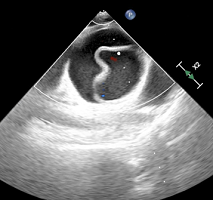INTRODUCTION
Neurofibromatosis (NF), are a group of hereditary diseases transmitted in an autosomal dominant fashion and characterized by a tendency to formation of ectodermal or mesodermal tissue tumours, possessing NF1 or NF2 gene mutation.1 Neurofibroma, a major feature of NF1 is a benign mass of peripheral nerve or nerve root consisting of Schwann cells, fibroblasts, mast cells and perineural cells.2 Literature is sparse regarding anaesthetic considerations for cervical neurofibromas.
CASE DISCUSSION
A 19-year-old female presented with complains of headache, pain in neck and weakness in bilateral upper and lower limbs, for three months. Motor power in upper and lower limbs was 4/5 with an intact bladder and bowel. Magnetic resonance imaging (MRI) cervical spine reported, a 2.2×3.8×4.4 cm lesion at the craniovertebral junction, extending through the left C1-C2 mural foramina into left paravertebral junction (Figure 1. MRI Spine of the patient with cervical neurofibroma). She was posted for tumour decompression via left posterolateral approach in prone position with head pin support.
Figure 1. MRI of Cervical Spine Showing the Neuro-fibromatous Lesion

On pre-operative evaluation, all routine blood investigations, electrocardiogram (ECG) and chest X-ray (CXR) were within normal limits. MRI angiography of the brain revealed hypoplastic right vertebral artery. Airway examination appeared normal, except for painful and restricted neck movements. Intra-operatively, patient was premedicated with injection midazolam and injection fentanyl. In view of anticipated difficult airway, modified rapid sequence induction with injection rocuronium (RSI) with manual in line stabilisation (MILS) and adequate preoxygenation was attempted. Video laryngoscopic guided intubation with cuffed endotracheal tubes (CETT) (#7.5 mmID) was smoothly done and bilateral air entry confirmed. Under all aseptic precautions, invasive arterial and central venous pressure lines were inserted and monitored. After completion of the surgery, a ‘Philadelphia collar’ was applied for cervical stability, followed by the removal of headpin support. Then she was positioned supine and extubated following standard protocol. The entire peri-operative course was uneventful and the patient was transferred to the neurosurgical intensive care unit (ICU) for further monitoring.
Cervical cord compression resulting from cervical nerve root fibroma is a recognized, but infrequently reported complication of NF1. Isolated cervical neurofibromas as in our patient can present at any age ranging from the first decade to the seventh decade of life. Cord compression occurs most commonly in the upper cervical spine at C2 and C3.3
Patients with symptomatic isolated cervical neurofibromas mostly present with progressive quadriparesis, paraparesis involving lower or upper extremities, incontinence, neck pain, headache, seizures. NF1 can involve the tongue, larynx, and aryepiglottic folds complicating airway management. Large neurofibromas originating in the mediastinum, retroperitoneal spaces, and cervical paraspinal areas can lead to progressive distal airway compression. Intrapulmonary neurofibromas may present with cough, dyspnea and associated-progressive pulmonary fibrosis. Also, there is an increased incidence of kyphoscoliosis in these patients. These can lead to difficult airway, respiratory complications and spinal cord compression. These patients can also have associated hypertension, cardiomyopathy, vasculopathy, pheochromocytoma and carcinoid tumours. Therefore, a thorough multi-system examination is mandatory pre-operatively.4
Surgical excision is associated with multiple challenges like ensuring adequate spinal cord exposure, preservation of involved spinal nerve roots, post-operative kyphosis prevention, stabilization of spine and reducing recurrence rates.5
Vertebral artery compression is another important concern in cervical neurofibromas, which is mostly displaced anteromedially by tumours. Hence, bilateral vertebral artery doppler or MRI angiogram of brain was done pre-operatively in the patient. As spinal cord perfusion pressure is the difference between mean arterial pressure and intra-spinal pressure ensuring spinal cord perfusion by maintaining haemodynamic status in the peri-operative period is vital for successful outcome.
CONCLUSION
To conclude, isolated cervical neurofibromas, although rare, can be a part of NF1. Multisystem presentation of NF1 can pose challenges for the anaesthesiologist if unaware of its problems. Also, ensuring cervical spine stability, avoiding spinal cord compression and maintaining cerebral and spinal cord perfusion are the major anaesthetic goals in the perioperative management of cervical neurofibroma. Cautious airway management in the neutral position, application of MILS during any maneuver, use of cervical collar, detailed work-up of neurofibromatosis patient and maintenance of hemodynamic stability are the cornerstones of successful patient outcome.
CONSENT
The authors have received written informed consent from the patient.
CONFLICTS OF INTEREST
The authors declare that they have no conflicts of interest.









